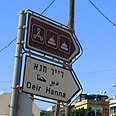
Dir Hana
צילום: יריב כץ
The bandit who became King of the Galilee
Hollywood scriptwriter should take on this murderous Galilean soap opera, but until that happens you can visit Dir Hana, main scene of action
Though our story’s hero was the respectable son of a respectable family, his name is still linked to the expression “every bastard a king,” and the tale told here really happened, more or less.
In the 18th century a minor king ruled in the Galilee, a Bedouin from the Zidan family called Taher al-Umar. His first years were spent in the alleyways of Tiberias and his family’s encampment in the Bet Netufa Valley, and he appears to have gotten involved in criminal activity and been forced to flee for his life to distant relatives in southern Syria, where he had a brilliant career as a promising thief.
He later returned to the haunts of his youth and became a star bandit. Not only was he an armed robber: He also collected protection money, and from there he moved on to customs duties and taxes, eventually turning on the Ottoman sultan in Istanbul and declaring independence in the “Kingdom of the Galilee.” In establishing his kingdom he also stole from his neighbors, the rulers of Sidon, Damascus, and Jaffa.
According to legend, in his youth he was taught to read and write by a Jew from Tiberias, which gave him a positive attitude toward Jews in later years. He even brought Jews from Lebanon to his “kingdom” to strengthen it economically. This is also the origin of the legend that the Jews of the Galilee have not abandoned the land of Israel since its destruction.
In typical Bedouin fashion, Taher al-Umar made sure his close relatives would enjoy his achievements, and in exchange he demanded their help whenever he needed horsemen, riflemen, and a few men to sow terror as a means of persuasion. He built castles and rebuilt destroyed fortresses left behind by the Crusaders, including those at Yehiam, Shfaram, and Tzipori, as well as the walls of Tiberias and Acre.
He ended his days an angry, embittered old man when he was forced to leave his capital, Acre, when the city was besieged by Turkish ruler Ahmed El-Jazar, the Sultan’s enforcer. His bodyguard betrayed him and cut off his head.
All in the family
Dir Hana is a large beautiful village in the eastern Sakhnin Valley. The settlement is ancient, and relics over 2,000 years old have been found in the village and its environs. The good food and the guest houses make it a welcoming place.
In 1732 Taher al-Umar and his brother Sa’ad al-Umar jointly ruled the Galilee. Sa’ad’s residence was in Dir Hana, and in that year he built a wall and towers around the village. On the hill he built a home with arches, domes, halls, and storerooms. Next to his palace-fortress he built a mosque and covered the walls with white and yellow stones.
We don’t know what aroused Taher’s anger, but histories of the period say that he ordered his son Uthman to murder Sa’ad, and told him he’d receive Shfaram as the prize. Uthman kept his part of the bargain, going to his uncle’s palace in Dir Hana and strangling him at night, but for various reasons Taher did not keep his end, and told people his brother had died at night from a snake bite.
Taher received no pleasure from his children, all of whom rebelled, each in his turn. One of the rebellions is connected to the half-destroyed palace on a hill in the village. Taher’s sons Ali and Uthman captured Dir Hana from their father and demanded that he fulfill his promise to give Shfaram to Uthman. Taher, a devotee of the “spare the rod and spoil the child” approach to life, took his army of horsemen, gunners, and infantrymen and besieged his rebellious sons in Dir Hana.
While the fighting family was killing itself and its soldiers, a messenger arrived at Taher’s camp and announced that his old enemy, the Pasha of Damascus, was about to attack him. Taher immediately sent a messenger to his besieged sons and ordered them to prepare dinner for him and several of his escorts, for he had something important to tell them.
The “rebels” did as their father-enemy asked, and as they were all sitting quietly eating dinner at the fortress, Taher told his sons about the coming war with the Pasha of Damascus. The family war council decided that Ali would lead the charge of Taher’s horsemen against the enemy from Damascus. If they managed to rid themselves of their common enemy they’d have time to continue their quarrel.
In 1775 Ahmed El-Jazar killed Taher al-Umar and became governor of Acre, conquering and destroying the fortress-palace-mosque in Dir Hana. Ali escaped to Lebanon and from there to the Golan Heights, and was ultimately murdered by soldiers of the Pasha of Damascus, which brought an end to the rule of this crazy family.
And the palace? The way it looks today, the story of the palace is a lot better than its physical condition, but it’s still beautiful, and the entire picturesque Sakhnin Valley can still be seen from its roof.
Where it is
Look for “Upper Galilee” and “Lower Galilee” on tourist maps and maps of marked trails (number 2 and 3). Dir Hana is found to the east of road number 805 in the Sakhnin Valley. Don’t enter the area of the fortress-palace without explicit permission from the owners.










